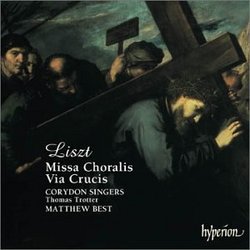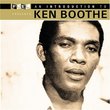| All Artists: Leigh Melrose, Franz Liszt, Matthew Best, Thomas Trotter Title: Liszt: Missa Choralis / Via Crucis Members Wishing: 0 Total Copies: 0 Label: Hyperion UK Release Date: 1/9/2001 Album Type: Import Genre: Classical Style: Opera & Classical Vocal Number of Discs: 1 SwapaCD Credits: 1 UPC: 034571171999 |
Search - Leigh Melrose, Franz Liszt, Matthew Best :: Liszt: Missa Choralis / Via Crucis
 | Leigh Melrose, Franz Liszt, Matthew Best Liszt: Missa Choralis / Via Crucis Genre: Classical
|
Larger Image |
CD DetailsSimilar CDs
|
CD ReviewsIntrospective Liszt Brett A. Kniess | Madison, WI | 11/05/2005 (5 out of 5 stars) "Liszt's sacred choral works are somewhat of an enigma. While his piano and orchestral music were looking forward and causing controversy, his choral music looks to the past and are, generally speaking, much more introverted and personal works. This CD has one mass, the Missa Choralis for chorus and organ, and a setting of the stations of the cross, the Via Crucis for chorus and organ. The Missa Choralis is kind of an odd duck; obviously influenced by the Catholic Church's past, particularly the Palestrina tradition and plainsong, it also looks forward with unusual progressions and unexpected harmonies. Liszt sets the five parts of the mass (Kyrie, Gloria, Credo, Sanctus and Benedictus, and Agnus Dei). The choral parts on the page are very singable, rarely utilizing outlandish leaps (a Palestrinian influence?), but the notes just don't go where you expect them to go. The opening of the Kyrie and Credo are definitely chant based, but Liszt puts them in a semi-dance-like garb. The outgoing Gloria and Credo are balanced by the beautifully lyric Sanctus, Benedictus, and Agnus Dei. The music seems perfectly written for a cathedral. The organ does little else but support the choir and the organ could easily be omitted altogether. Via Crucis is a setting of 14 pictures or scenes leading to the cruxifiction and eventual resurrection of Christ. Much more programmatic then the Mass, Liszt seems more able to express his innate sense of Romanticism through a visual program. The organ plays a major role as soloist in this work and lets Liszt create as many timbres as he needs. Highly emotional, the subject matter is very intense and the music portrays it well. From Jesus taking up the cross, to being nailed to the cross, to being laid in the tomb, this 30+ minute work is emotionally draining. Liszt utilizes chorus and soloists in many different combinations to tell the story, and the harmonic language is very advanced, yet the overall nature is very subdued and serious. A very unique work. The English based Corydon Singers sing extremely well on some difficult music (they make it seem easy). The church they are performing in is very spacious, but this does not diminish the cleanliness of sound, nor does the organ drown out the chorus. While Liszt's works represented here are not the showstoppers we are used to, they provide a glimpse into a highly spiritual man. The music is intense and beautiful, great choir music by an instrumental master." This is outstanding! Kurt Miller | live oak, fl United States | 01/14/2007 (5 out of 5 stars) "Liszt's choral works are a bit of a innovation. While he was causing controversy with his invention of the 'symphonic poem', his sacred choral works were often criticized because of their secular background.
The Corydon Singers have performed his 'Missa Choralis' very well. Sometimes, I feel that it is quite moving-especially in the Credo, when the choir proclaims the first paragraph of the Latin text. Then it becomes slow and solemn at the part where the soloists tell of the Life of our Lord Jesus Christ. The choir once again returns to it's other tempo at the Ressurection as Christ triumph's over death. The 'Via Crucis' is a rather odd work. It obviously, was Liszt's depiction of the fourteen stations in the catholic church starting where Jesus Christ is condemned to death and ending with his burial in the tomb. The 'Via Crucis' has instrumental 'movements' where the organ has solos, and Thomas Trotter has done a fairly well job. I highly recomend this for those who appreciate pure and clear voices. Oh, and don't worry if you can't understand Latin or German. The paper inside gives an English translation." |

 Track Listings (21) - Disc #1
Track Listings (21) - Disc #1

